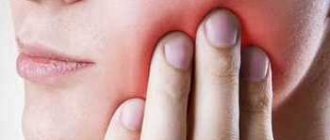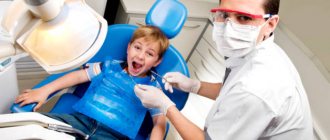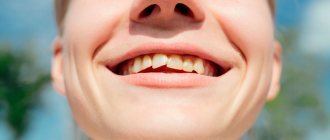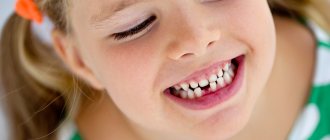Children's teeth appear in a certain sequence and in pairs (for example, two central incisors or two canines). But often the timing of teething in children shifts upward: many parents begin to worry and get nervous, but this is not worth doing, since the deviation from the norm is explained by the individual characteristics of the body, the uncharacteristic course of pregnancy, or various injuries received during childbirth.
Teething in children and features of this process
Quite often, a few weeks before the appearance of a baby or molar tooth, a lump filled with a clear or bluish liquid forms on the gum. Naturally, it worries parents, but there is no pathology in this formation, and the lump, which does not look very aesthetically pleasing, does not indicate the beginning of the inflammatory process. In most cases, no intervention by a doctor is required. You can contact the dentist if the lump increases in size: the doctor will make a small incision and release the liquid.
Baby teeth in children: order of eruption
Any newborn baby has follicles of milk teeth (20 pieces) and molars (16 pieces) inside the jaws. The remaining 16 rudiments will form later.
Teething in infants begins with the lower jaw: first the central incisors appear (6-10 months of the child’s life), then the canines (10-13 months), then comes the turn of the first (14-18 months) and second (17-23 months) molars .
Emerging teeth differ from adult teeth in having low-mineralized enamel. If you do not maintain oral hygiene, caries may begin to develop. In addition to careful adherence to hygiene rules, special gels and ointments that significantly accelerate the mineralization process will help make teeth stronger and more resistant to pathogenic microorganisms.
How is milk teeth removed for orthodontic reasons?
If a young patient has crowded teeth, the offending primary teeth should be removed to avoid bite problems during primary replacement.
This dental procedure takes place in four stages:
- Removal of primary posterior incisors at the time of eruption of permanent incisors.
- Extraction of primary canines (this is necessary for the proper growth of permanent incisors).
- Extraction of primary first molars, provided that the first premolars are 1/2 to 2/3 the length of the root.
- Stage four: removal of permanent first premolars before the eruption of permanent canines to make room for them.
Approximate timing of eruption of permanent teeth
The first of the molar permanent teeth to appear are molars (at the 6th year of life), located at the end of the dentition. But it is they who are most susceptible to caries, since there are deep depressions on their surface where bacteria accumulate due to poor cleaning and neglect of flossing.
The second molar appears 4-6 years later, when the child reaches 11-13 years of age. Incisors erupt at 6-8 years of a person’s life, canines - after 9 years of age.
Like newly emerged milk teeth, permanent teeth contain few minerals (a tenth of their amount in a mature adult). It is for this reason that it is important to teach a child proper hygiene. It wouldn’t hurt to treat your teeth with gels containing a large amount of fluoride once a quarter.
When do baby teeth fall out?
“Childhood is over,” some parents say to their children whose baby teeth have been replaced by molars. Of course, this statement is mostly in a humorous form, since the average age when a child’s dentition ends is 12 years. At this time, the time of adolescence begins - one of the most interesting and eventful periods of our lives. As is the case with the eruption of baby teeth, their loss does not have a clear age limit. For example, today dentists are increasingly noting the early appearance of a full set of molars (as early as 10–11 years), whereas 20–30 years ago this could occur in adolescence (at 14–15 years). The service life of each baby tooth is on average 3-4 years: before the process of changing the dentition begins, the roots of the baby teeth are absorbed, so their loss does not bring severe pain and discomfort to children. Below is a table with the approximate timing of the loss of different groups of baby teeth.
Milk teeth on the lower jaw
| Name of teeth | Drop time |
| Central incisors | 5 - 6 years |
| Lateral incisors | 7 - 8 years |
| Fangs | 9 - 10 years |
| Premolars | 10 - 11 years |
| Molars | 11 - 12 years |
Milk teeth on the upper jaw
| Name of teeth | Drop time |
| Central incisors | 7 - 8 years |
| Lateral incisors | 8 - 9 years |
| Fangs | 10 - 11 years |
| Premolars | 11 - 12 years |
| Molars | 12 - 13 years old |
**Note: The first molar becomes the sixth molar, which does not have a primary tooth and erupts on its own at the back of the jaw.
Teething in children: symptoms
The first signs of the imminent appearance of teeth appear about a week before their appearance. The symptoms will not stop until the tooth breaks through the gum lining.
Signs of teething in a baby are as follows:
- the child becomes irritable for no reason;
- sleep deteriorates (if the child cries at night and tosses and turns, there is no need to immediately start rocking him to sleep - it is better to give the baby the opportunity to calm down on his own);
- the gums become very swollen and swell at the site where the tooth appears;
- the appetite deteriorates, the baby may even refuse to eat altogether, feeling hungry;
- the child begins to chew on various objects to relieve severe itching in the gums;
- salivation increases;
- Due to drooling, a rash may appear around the mouth, chin and chest.
There are also additional ones, i.e. optional symptoms of teething in infants:
- heat. If the temperature has increased, this most likely indicates an inflammatory process that develops in parallel with teething and is in no way connected with it (it could be stomatitis or any cold).
When the temperature rises, you need to carefully examine the oral mucosa. If there are small bubbles filled with a cloudy liquid, erosion, and the gums themselves are bright red, then the child has herpetic stomatitis. Any baby receives antibodies to the herpes virus from its mother, but usually by the time the first teeth appear, their effect ends. Often the catalyzing factor in the development of stomatitis is trauma to the mucous membrane, which is inevitable when teeth appear. If the above signs cannot be detected, then it is recommended to give the baby Panadol (suppositories are the preferred form of medication). As practice shows, it is useless to call a pediatrician, since this is not their specialization. Only a dentist can determine the specific type of stomatitis (aphthous, herpetic, etc.).
- hematomas on the gums. Sometimes the gums become swollen, turning an eerie shade of blue. Despite their frightening appearance, hematomas do not require treatment. Doctor intervention is allowed only for large hematomas that do not decrease over a long time.
- vomit. The only acceptable cause of vomiting is excess saliva entering the stomach and esophagus. If vomiting begins against the background of elevated temperature and, especially, diarrhea, then these symptoms have nothing to do with teething - you need to call a doctor.
- coughing is not a natural cause when teeth appear, unless the child has swallowed saliva that has entered the respiratory tract.
- A runny nose is a sign of a cold, not teething.
When is a child's dental x-ray prescribed?
It is important for parents to understand in what cases it is necessary to take an x-ray of children’s baby teeth. Detailed diagnostics may be required in a variety of cases (depending on the individual characteristics of the structure and development of the dental system). Most often, radiographic examinations are prescribed in the following cases:
- To identify deep caries. Milk teeth, unlike permanent teeth, have more fragile enamel. Consequently, they are more susceptible to exposure to aggressive substances that enter the mouth with food. Carbonated drinks, fast food, sweets - all this causes the appearance of caries, which is not always noticeable upon visual inspection. At routine visits to the dentist, with x-rays, you can verify the absence or confirm the presence of deep caries.
- To study abnormalities in the development of teeth and jaws. If a child has problems with teething, abnormal growth, or pain when closing the jaws, this may be a reason to take an X-ray of the children’s baby teeth. The results will allow us to study the existing problems in detail and intervene in a timely manner, solving issues of delayed growth of units and many others.
- To monitor the condition of permanent teeth. Not only baby teeth, but also permanent children’s teeth require special attention even before they appear. Studying the rudiments allows not only to determine possible anomalies, but also to make predictions about the timing of eruption.
- Bite study. An incorrect bite can cause premature tooth wear and the appearance of various pathologies. An X-ray of a child’s teeth can provide detailed data on the position of the jaws in order to identify even the slightest deviations from the norm.
- Detection of abscesses. Inflammatory processes in the initial stages may be asymptomatic. An advanced abscess can cause serious operations, including surgical ones. At the same time, x-rays can show foci of inflammation and begin treatment on time.
Some children are so mobile and active that they often get injured, including in the jaw. Serious injuries may be visible during visual inspection, and some cracks and misalignments can only be diagnosed after X-raying the child's teeth.
Caring for children's teeth
The pattern of teething in children determines the approximate time of their appearance, but it is necessary to start observing oral hygiene as early as possible, without waiting for the teeth to erupt.
Breasts cannot take care of themselves, so they need help cleaning their gums. This is done either with the help of a fingertip, or, if there is none, with the help of an ordinary bandage dipped in warm boiled water and wound around the finger.
If teeth begin to erupt, you cannot do without the use of special products (baby pastes, brushes, etc.).
What are the indications for the removal of baby teeth?
Common carious lesions are the most common indications for the procedure. However, this is not the only reason. One of the common indications for the removal of primary teeth is their abnormal growth, which increases the risk of malocclusion and problems during the eruption of permanent teeth.
Other indications for the removal of baby teeth are:
- the occurrence of dental diseases that can cause tissue necrosis;
- diagnosis of periodontal fistulas and abscesses, as well as other pathological changes in the gums;
- too late resorption of milk roots, which prevents the eruption of permanent teeth;
- mechanical damage that may occur as a result of a child falling.
An indication may also be the fact that a baby tooth remains in the dental arch for too long, despite the fact that the permanent one has already begun to erupt. A tooth should also be removed when it begins to move and thus makes it difficult for the child to eat and speak. In such a situation, you should not pull it out using old home methods, because this can damage the gums.
Types of teething disorders
Teething in children, the sequence of which is clearly defined, can occur with a delay caused by various reasons (illness of the mother during pregnancy, diseases suffered by the child, etc.). Due to the delay, deformation of the jaws may begin, because There is not enough free space for teeth that have not yet erupted. In this case, only the dentist can decide on treatment after a thorough visual examination of the child and analysis of the photograph taken.
The next very common disorder is enamel hypoplasia, which manifests itself in spots of different colors on newly emerging teeth, pits or grooves. Hypoplasia causes complications during pregnancy.
Why do teeth erupt with irregularities?
The condition of a child’s teeth in the first years of life depends on the health of the mother during pregnancy. The formation of hard dental tissues may be disrupted if a woman:
- suffered from toxicosis at the initial stage of pregnancy;
- experienced severe prolonged stress;
- was treated for kidney disease;
- suffered from rubella.
In addition to maternal diseases, the maturation of teeth and the development of the jaw system can be affected by:
- fetal prematurity or, conversely, delayed birth;
- conflict of Rh factors;
- sepsis suffered by a child in the first month of life;
- frequent colds, pneumonia;
- convulsions;
- toxicosis;
- refusal to breastfeed.
Often, parents, driven by the best intentions, want to alleviate the baby’s suffering by giving him medications. You must understand that any medicine, even if it seems completely safe, cannot be taken without consulting a pediatrician!










